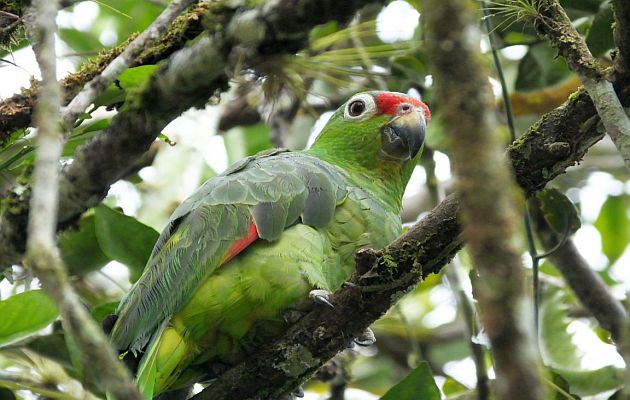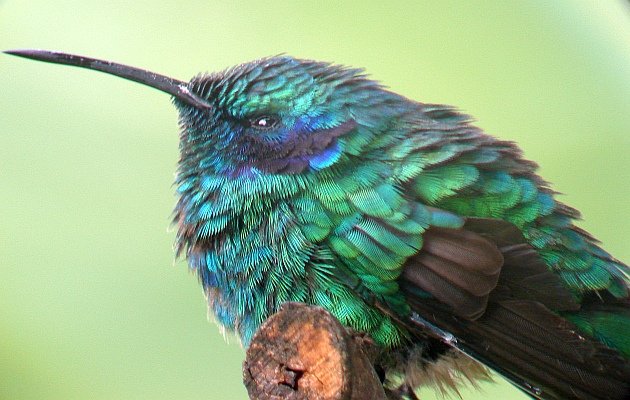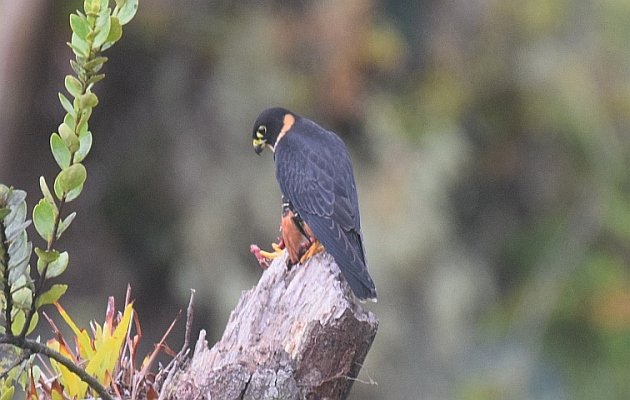
Binoculars are like a magical optical portal. Without looking through polished sets of coated glass, birds can be itty-bitty specks and flying objects that hint at the colors hidden therein. Bring the binos up to the eyes, work the focus, and if the bird is nice enough to still be there, life can take on new meaning. A dull and chunky looking Starling becomes a flashy, funky bird with iridescent, slick, hair-like feathers. A Northern Cardinal really does have an orange-red bill and the female ends up being much more subtly beautiful colors than expected. All of a sudden, you have a superpower where you can scan and find more birds, where warblers become identifiable, veritable jewels, where you feel transported closer to the bird.

Life is good when you can inspect the plumage of a hummingbird. This one is a Lesser Violetear from Costa Rica.
No matter where you watch birds, binos leverage that surreal connection. They are imperative for any birding venture, every international trip, but what about their more powerful cousin, the scope? Non-birders assume it’s a camera (can’t really blame them) or even a telescope for looking at the stars, but no, this here piece of fine gear is a spotting scope, the optical game-changing tool that opens bigger doors to birding. It’s all about getting closer and a good scope is the wizard that places you out there on the mud flat with the shorebirds, helps you realize, appreciate, and inspect the intricate beauty of dowitcher plumage, transports you beyond the breakers to where sea ducks fly, even out to the edge of the shearwater zone.
Given the utility of powerful optics, a scope while birding near home is always a treat. But travel with a scope on a plane? And in the time of baggage limits and birding trips where we are encouraged to carry less and strive to do so? It’s easy to question bringing a scope, especially when taking a birding trip to Costa Rica because how often are you going to be looking at shorebirds?

There might be some shorebirds to look at in Costa Rica…
How much seawatching do you plan on doing? Won’t it be a pain to carry in the forest, just dead optic weight in shaded places where birding requires a quick-draw of the binos? Lugging that spotting scope to Costa Rica is certainly debatable (and if you are on a tour, your guide will probably have one anyways) but here are a few reasons why it might be worth your while:
It Comes in Handy
When birding in rainforest, at least at the edge of forest, there are always birds that are just a bit too far, even for the magic of binoculars. Rainforest trees can be dinosaur tall, believe me, if a mixed flocks of tanagers and other small birds zips into some massive fruiting tree, you will be wanting that scope! The same goes for opportunities when you can scan the canopy of a forested hillside or watch from a canopy tower. An optical sweep can turn up distant perched parrots, raptors and other avian niceties all brought into the realm of identification and better appreciation by the superpowers of the scope.

Scoped views of parrots are a gift. This is a Red-lored Parrot from northern Costa Rica.
Don’t Miss Lifers!
Obvious emphasis on this point. This might be your only chance to go birding in Costa Rica, do not miss out on lifers! A scope ups the lifer odds in your favor because it always helps bring you closer to more birds. The more birds you check out and see, the more end up being lifers. It worked for me on several occasions in Thailand, it will also help in Costa Rica.

You don’t want to miss a Bat Falcon.
Maybe You Do Want to Look at Shorebirds and the Sea?
It might just be for a day, an afternoon of birding or during a lunch interlude in some seaside restaurant. No matter what brings you close to the sea, scoping could always turn up something new. As for shorebirds, in winter and migration, Costa Rica has a lot to look at and a scope is essential for the job.
You Don’t Always Have to Carry it Around
Not to mention, even if your scope and tripod do happen to be made of light carbon fiber materials, if you don’t feel like carrying it around, you don’t have to. It might be worth it but if you insist on taking a break from the scope, you could always leave it back in the hotel room or on the birding bus (during a tour).
None of this means that a scope is necessary for birding in Costa Rica, but, it just might give that extra chance to see and appreciate more birds. It’s partly why so many good birding guides always have one. It sort of is like a superpower after all.













This is actually a topic I was thinking of after my first and only Costa Rica tour. I did used the scope 2 or 3 times in a week, so it clearly was mostly a dead weight. Anyway, the guide had the scope, of course.
Nowadays I’d probably carry only 8s or 10s, but at the moment I am testing the new Swarovski 12×42, of which you will hear more here at 10,000 Birds, but one interesting aspect of it is, for shorter distances, it can replace the scope! Yet, you’d hate using it inside the forest.